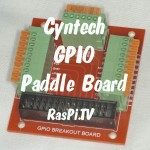
This is part 2 in a series on WiringPi 2 for Python. The basics are covered in part 1 (click here). You should read that first if you haven’t already, as we build on it here in part 2. Today we’ll cover three things… 1. Raspberry Pi board revision checking with WiringPi2 for Python 2. Using the Raspberry Pi’s internal pull-ups and pull-downs with WiringPi2 for Python 3. Using hardware PWM with WiringPi2 for Python 1. Checking your Raspberry Pi board revision number in WiringPi2 It’s quite useful to be able to check what version […more…]








